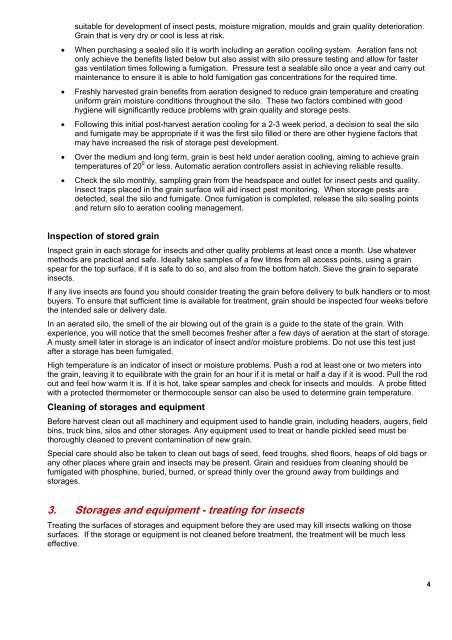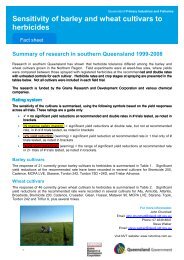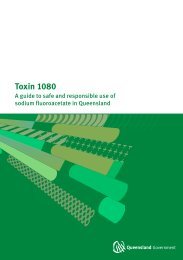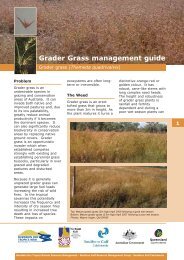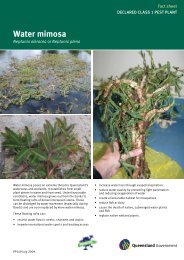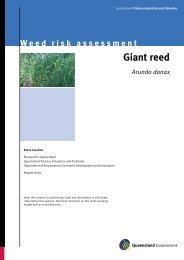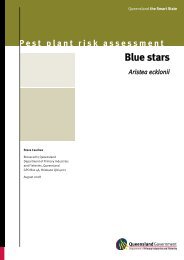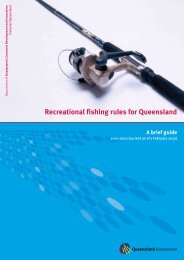Insect Control in Stored Grain - Department of Primary Industries
Insect Control in Stored Grain - Department of Primary Industries
Insect Control in Stored Grain - Department of Primary Industries
Create successful ePaper yourself
Turn your PDF publications into a flip-book with our unique Google optimized e-Paper software.
suitable for development <strong>of</strong> <strong>in</strong>sect pests, moisture migration, moulds and gra<strong>in</strong> quality deterioration.<br />
Gra<strong>in</strong> that is very dry or cool is less at risk.<br />
• When purchas<strong>in</strong>g a sealed silo it is worth <strong>in</strong>clud<strong>in</strong>g an aeration cool<strong>in</strong>g system. Aeration fans not<br />
only achieve the benefits listed below but also assist with silo pressure test<strong>in</strong>g and allow for faster<br />
gas ventilation times follow<strong>in</strong>g a fumigation. Pressure test a sealable silo once a year and carry out<br />
ma<strong>in</strong>tenance to ensure it is able to hold fumigation gas concentrations for the required time.<br />
• Freshly harvested gra<strong>in</strong> benefits from aeration designed to reduce gra<strong>in</strong> temperature and creat<strong>in</strong>g<br />
uniform gra<strong>in</strong> moisture conditions throughout the silo. These two factors comb<strong>in</strong>ed with good<br />
hygiene will significantly reduce problems with gra<strong>in</strong> quality and storage pests.<br />
• Follow<strong>in</strong>g this <strong>in</strong>itial post-harvest aeration cool<strong>in</strong>g for a 2-3 week period, a decision to seal the silo<br />
and fumigate may be appropriate if it was the first silo filled or there are other hygiene factors that<br />
may have <strong>in</strong>creased the risk <strong>of</strong> storage pest development.<br />
• Over the medium and long term, gra<strong>in</strong> is best held under aeration cool<strong>in</strong>g, aim<strong>in</strong>g to achieve gra<strong>in</strong><br />
temperatures <strong>of</strong> 20 0 or less. Automatic aeration controllers assist <strong>in</strong> achiev<strong>in</strong>g reliable results.<br />
• Check the silo monthly, sampl<strong>in</strong>g gra<strong>in</strong> from the headspace and outlet for <strong>in</strong>sect pests and quality.<br />
<strong>Insect</strong> traps placed <strong>in</strong> the gra<strong>in</strong> surface will aid <strong>in</strong>sect pest monitor<strong>in</strong>g. When storage pests are<br />
detected, seal the silo and fumigate. Once fumigation is completed, release the silo seal<strong>in</strong>g po<strong>in</strong>ts<br />
and return silo to aeration cool<strong>in</strong>g management.<br />
Inspection <strong>of</strong> stored gra<strong>in</strong><br />
Inspect gra<strong>in</strong> <strong>in</strong> each storage for <strong>in</strong>sects and other quality problems at least once a month. Use whatever<br />
methods are practical and safe. Ideally take samples <strong>of</strong> a few litres from all access po<strong>in</strong>ts, us<strong>in</strong>g a gra<strong>in</strong><br />
spear for the top surface, if it is safe to do so, and also from the bottom hatch. Sieve the gra<strong>in</strong> to separate<br />
<strong>in</strong>sects.<br />
If any live <strong>in</strong>sects are found you should consider treat<strong>in</strong>g the gra<strong>in</strong> before delivery to bulk handlers or to most<br />
buyers. To ensure that sufficient time is available for treatment, gra<strong>in</strong> should be <strong>in</strong>spected four weeks before<br />
the <strong>in</strong>tended sale or delivery date.<br />
In an aerated silo, the smell <strong>of</strong> the air blow<strong>in</strong>g out <strong>of</strong> the gra<strong>in</strong> is a guide to the state <strong>of</strong> the gra<strong>in</strong>. With<br />
experience, you will notice that the smell becomes fresher after a few days <strong>of</strong> aeration at the start <strong>of</strong> storage.<br />
A musty smell later <strong>in</strong> storage is an <strong>in</strong>dicator <strong>of</strong> <strong>in</strong>sect and/or moisture problems. Do not use this test just<br />
after a storage has been fumigated.<br />
High temperature is an <strong>in</strong>dicator <strong>of</strong> <strong>in</strong>sect or moisture problems. Push a rod at least one or two meters <strong>in</strong>to<br />
the gra<strong>in</strong>, leav<strong>in</strong>g it to equilibrate with the gra<strong>in</strong> for an hour if it is metal or half a day if it is wood. Pull the rod<br />
out and feel how warm it is. If it is hot, take spear samples and check for <strong>in</strong>sects and moulds. A probe fitted<br />
with a protected thermometer or thermocouple sensor can also be used to determ<strong>in</strong>e gra<strong>in</strong> temperature.<br />
Clean<strong>in</strong>g <strong>of</strong> storages and equipment<br />
Before harvest clean out all mach<strong>in</strong>ery and equipment used to handle gra<strong>in</strong>, <strong>in</strong>clud<strong>in</strong>g headers, augers, field<br />
b<strong>in</strong>s, truck b<strong>in</strong>s, silos and other storages. Any equipment used to treat or handle pickled seed must be<br />
thoroughly cleaned to prevent contam<strong>in</strong>ation <strong>of</strong> new gra<strong>in</strong>.<br />
Special care should also be taken to clean out bags <strong>of</strong> seed, feed troughs, shed floors, heaps <strong>of</strong> old bags or<br />
any other places where gra<strong>in</strong> and <strong>in</strong>sects may be present. Gra<strong>in</strong> and residues from clean<strong>in</strong>g should be<br />
fumigated with phosph<strong>in</strong>e, buried, burned, or spread th<strong>in</strong>ly over the ground away from build<strong>in</strong>gs and<br />
storages.<br />
3. Storages and equipment - treat<strong>in</strong>g for <strong>in</strong>sects<br />
Treat<strong>in</strong>g the surfaces <strong>of</strong> storages and equipment before they are used may kill <strong>in</strong>sects walk<strong>in</strong>g on those<br />
surfaces. If the storage or equipment is not cleaned before treatment, the treatment will be much less<br />
effective.<br />
4


